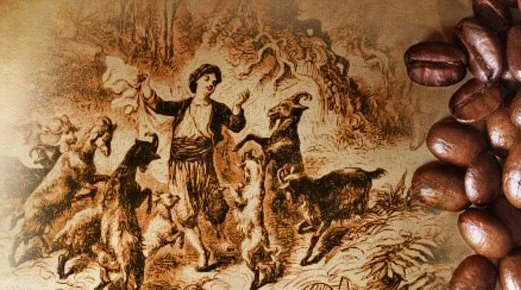The history of coffee
The story begins in Ethiopia with a goat herder named Kaldi. Legend has it that Kaldi noticed his goats were unusually energetic after eating the bright red berries from a certain bush. Curious, he tried the berries himself and soon after felt a similar burst of vitality. Excited by this discovery, Kaldi took the berries to a local monastery.
At the monastery, a monk disapproved of the energising fruit and threw them into the fire; instead of burning, the berries released a rich, aromatic scent. The roasted beans were quickly raked from the fire, ground and steeped in hot water, creating the world's first cup of coffee.
Kaldi the goat-herder with his energetic, caffeinated goats.
While Kalid’s story is steeped in myth, historical evidence shows that coffee cultivation and trade began in Arabia around the 15th century, particularly in Yemen. The drink was known as qahwa and was often consumed in Sufi monasteries to aid with concentration and wakefulness during long nights of prayer.
By the 16th century, coffee had spread to Mecca, Cairo, and Istanbul, becoming a vital part of Islamic culture. Coffeehouses, known as qahveh khaneh, became hubs of intellectual exchange, storytelling, music and politics, earning the nickname ‘schools of the wise’.
Coffee in Europe
Coffee arrived in Europe in the 17th century, initially through Venetian merchants. Initially, it was met with some scepticism. To begin with, some people named coffee ‘the bitter invention of Satan,’ but when Pope Clement VIII tasted it and declared it delicious, coffee's reputation shifted.
Soon, coffeehouses sprang up across Italy, England, France and Austria, serving as gathering places for artists, scientists and political thinkers. In England, they were called ‘penny universities’ because for the price of a penny, you could gain access to stimulating conversation and news.
Coffee Goes Global
As demand grew, European powers sought to cultivate coffee outside of the Arab world. The Dutch were the first to successfully grow coffee in Java (Indonesia) in the 1600s. The French brought it to the Caribbean, the Portuguese to Brazil, and the Spanish to Central America. Brazil soon became the largest coffee producer in the world and still is today.
Modern Coffee Culture
In the 20th century, coffee became industrialised, and instant coffee was invented. Brands like Nescafé and Maxwell House took off, and the morning cup became such a huge part of people's morning routines.
Then came the speciality coffee movement in the 1900s and 2000s, with an emphasis on origin, roasting methods and brewing techniques. Coffee shops popularised espresso-based drinks, and today coffee is a £100 billion global industry with over 2 billion cups consumed daily.
The Coffee House
At The Coffee House, we embrace the tradition of the original ‘coffeehouses’ by creating warm, welcoming spaces that encourage connection, conversation, and a sense of belonging - much more than just a place to grab a cup of coffee.




